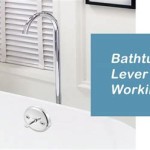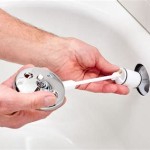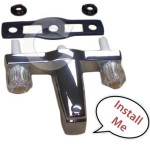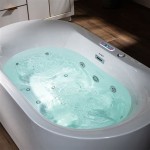Can You Remove a Bathtub Surround? A Comprehensive Guide
Bathtub surrounds, also known as tub surrounds or shower surrounds, are commonly installed to protect bathroom walls from water damage and provide a clean, aesthetically pleasing finish. They typically consist of multiple panels made from materials like acrylic, fiberglass, or tile. While these surrounds offer benefits, there may be times when removal becomes necessary. This could be due to damage, the desire for a bathroom remodel, or the need to access plumbing behind the surround. Understanding the process of removing a bathtub surround is crucial for a successful outcome, whether undertaken as a DIY project or by a professional.
The feasibility of removing a bathtub surround depends on several factors, including the material of the surround, the method of installation, and the condition of the surrounding walls. Generally, surrounds that are glued directly to the wall surface present more challenges than those attached with screws or clips. Tile surrounds, while durable, require careful removal to avoid damaging the underlying wall structure. This article will delve into the considerations and steps involved in safely and effectively removing a bathtub surround, regardless of its composition.
Assessing the Bathtub Surround and Wall Condition
Before commencing any removal work, a thorough assessment of the bathtub surround and the surrounding walls is paramount. This involves identifying the type of material the surround is made of – acrylic, fiberglass, plastic, or tile – as well as determining how it is affixed to the wall. Most surrounds are attached using a combination of adhesive, screws, and caulk or sealant. The type and strength of the adhesive used can significantly impact the removal process. Strong adhesives may require more aggressive methods, potentially increasing the risk of wall damage.
The condition of the surrounding walls is another critical factor. Walls that are already damaged, such as those with mold or water damage, may be more vulnerable during the removal process. In such cases, extra caution is necessary to prevent further deterioration. It is also important to identify the wall material, which could be drywall, plaster, or cement board. Different wall materials react differently to the stresses of surround removal, and appropriate techniques should be employed to minimize damage.
Tools and materials needed for the removal will vary based on the surround type and installation method. Safety glasses, gloves, and a dust mask are essential for personal protection. Other common tools include a utility knife, putty knife, pry bar, oscillating multi-tool, screwdriver, hammer, and potentially a heat gun for softening adhesive. Cleaning supplies, such as mineral spirits or adhesive remover, may also be helpful for removing residual adhesive after the surround is detached.
Step-by-Step Guide to Removing a Bathtub Surround
The process of removing a bathtub surround involves several distinct steps, each requiring careful attention to detail. The following is a general guide, but specific procedures may need to be adjusted based on the unique characteristics of the installation:
1. Preparation and Safety:
Before starting, turn off the water supply to the bathtub faucet. Cover the bathtub basin with a protective material, such as a drop cloth or cardboard, to prevent damage from falling debris. Ensure adequate ventilation and wear appropriate safety gear, including safety glasses, gloves, and a dust mask.
2. Removing Caulk and Sealant:
Carefully remove all caulk and sealant around the perimeter of the bathtub surround using a utility knife. Cut along the edges where the surround meets the bathtub, walls, and ceiling. A flexible caulk removal tool can be helpful for this step. Ensure all caulk and sealant are removed, as they can hinder the separation of the surround from the wall.
3. Locating and Removing Fasteners:
Inspect the surround for screws or other fasteners. These are often located along the edges or in the corners of the panels. Use a screwdriver to remove any visible screws. Some surrounds may have hidden fasteners covered by decorative caps, which need to be carefully pried off before the screws can be accessed.
4. Separating the Surround from the Wall:
Begin separating the surround from the wall using a putty knife or a thin pry bar. Start at a corner or edge where the surround seems loosest. Gently insert the putty knife or pry bar between the surround and the wall, and slowly work your way around the perimeter. Avoid excessive force, which can damage the wall. If encountering strong resistance, consider using a heat gun to soften the adhesive, focusing on small areas at a time.
5. Dealing with Adhesive:
Adhesive is the most common obstacle during surround removal. If the surround is heavily glued, an oscillating multi-tool with a scraper blade can be used to cut through the adhesive behind the panels. Work slowly and carefully to avoid damaging the wall. Applying heat from a heat gun can also help soften the adhesive, making it easier to separate the surround. In some cases, adhesive remover products may be necessary, but be sure to test them in an inconspicuous area first to ensure they do not damage the wall surface.
6. Removing the Panels:
Once the surround panels are sufficiently loosened, carefully remove them one at a time. If the panels are large or heavy, it may be helpful to have a second person assist with the removal. Gently pull the panels away from the wall, working from one edge to the other. If any sections remain strongly adhered, use the putty knife or oscillating multi-tool to further separate them.
7. Cleaning the Wall Surface:
After removing the surround panels, clean the wall surface to remove any remaining adhesive residue, caulk, or debris. Use a scraper or putty knife to remove larger pieces of adhesive, and then clean the surface with mineral spirits or adhesive remover. Allow the wall to dry completely before proceeding with any further repairs or installations.Addressing Potential Challenges and Wall Repairs
Removing a bathtub surround can sometimes reveal underlying issues with the wall structure. Water damage, mold growth, or crumbling drywall are common problems that may require attention. Addressing these issues is crucial before installing a new surround or making other bathroom renovations.
Water damage can compromise the structural integrity of the wall and provide a breeding ground for mold. Any affected areas should be thoroughly cleaned and treated with a mold-killing solution. Severely damaged drywall or plaster may need to be replaced. This involves cutting out the damaged section, installing new drywall or plaster, and then patching and sanding the surface to create a smooth finish.
Repairing holes or imperfections in the wall is also important for a professional-looking result. Small holes can be filled with spackle or joint compound, while larger holes may require the installation of drywall patches. Sand the patched areas smooth and prime them before painting or installing a new wall covering. Careful preparation of the wall surface will ensure that the new surround or finish adheres properly and provides a long-lasting, watertight seal.
Choosing the appropriate replacement for the removed surround is another important consideration. The options range from new acrylic or fiberglass surrounds to tile installations. Each material has its own advantages and disadvantages in terms of cost, durability, aesthetics, and ease of installation. Thoroughly research the available options and select a material that meets the specific needs and preferences of the homeowner.
Proper installation of the new surround is essential to prevent future water damage and ensure a long lifespan. Follow the manufacturer's instructions carefully, and use appropriate adhesives, sealants, and fasteners. Pay close attention to detail when caulking the seams and edges of the surround to create a watertight seal. Consider hiring a professional contractor if the installation process seems too complex or if there are concerns about achieving a high-quality result.
Removing a bathtub surround is a task that requires careful planning, preparation, and execution. By assessing the surround and wall condition, following a step-by-step removal process, and addressing any underlying issues, it is possible to successfully remove a bathtub surround without causing significant damage. Addressing potential challenges and ensuring proper wall repairs will contribute to a professional and long-lasting result, whether the goal is a bathroom remodel or simply accessing plumbing for repairs.

Semi Diy Bathroom Remodel Replacing A Tub Surround The Bathtub Tile

Removing A Fiberglass Bath And Surround

How To Remove A Fiberglass Bathtub And Surround By Home Repair Tutor

Tub Surround Removal Shower Replacement Course

How To Demo Remove A Tiled Bathtub Platform Surround Without Breaking Plumbing Pipes Fixtures

How To Remove Bathtub Shower Wall Tiles

Remove And Replace Fiberglass Tub Enclosure

Semi Diy Bathroom Remodel Replacing A Tub Surround The Bathtub Tile

How To Remove And Replace A Bathtub The Home Depot With Thisoldhouse

Remove Tub Shower Enclosure Nc Master Plumber Llc








